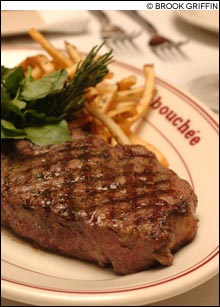
MAIS OUI: The Back Bay Restaurant Group brings a French brasserie to Back Bay.
|
Bouchée does so many things well that even some of its drawbacks may be successful. For example, the menu is stereotyped like that of the ’50s French restaurant it replaced (DuBarry, after a long hiatus), but that may make it even better for those who remember the old onion soup–snails–duck–mousse formula of French restaurants and those who are discovering such restaurants for the first time. Not everyone wants culinary innovation, or the specific culinary innovations that French restaurants have made both here and in France since the 1960s.
Should these innovations prove necessary, however, executive chef Tim Partridge (from the now-extinct Perdix) has the training and experience to go to nouvelle cuisine or grill-bistro. His roadmap here was that of any French driver: travelright down the middle and weave as necessary at high speed. Yet the Back Bay Restaurant Group, which owns 31 other restaurants, took time and care expanding this space: opening up a complicated subterranean room to a large bar and dining area, and remaking a double storefront into a second dining room set above street level (which DuBarry never had). Decoration is no problem either, since the group’s origins lie in the old Charlie’s Eating and Drinking Saloon. Once you translate that turn-of-the-century saloon into French, you have an art-nouveau brasserie.
Food is also kind of standardized. In fact, when our server offered us a choice of round sourdough rolls or longer mini-baguettes, they were both crusty white breads and tasted the same. It’s a French restaurant, so you get foil-wrapped butter and portion-controlled Promise spread instead of a pour of olive oil.
For appetizers, the plate of olives ($5) is generous and varied with four identifiable types. I especially like the tiny marinated ones. The salade Bouchée ($8) is big and very good, with a variety of greens, real cherry tomatoes, sliced radishes and onions, and “lardons,” which are similar to crunchy bacon sandwiches.
Escargot ($8) tastes exactly as always (like garlic butter), except that Bouchée dispenses with the shells and serves them naked in a deeply indented plate. Baked raclette ($8), the French answer to fondue, is served in a mini frying pan with excellent, fully ripe bosc-pear parts already under the melty cheese, and slices of toasted baguette to pick up any loose cheese at the end.
The most impressive main dish I tried was cassoulet ($26/$42 for two): the baked beans were done with a meltingly braised chunk of fresh pork, a full leg of confit duck, and a fine, lean lamb sausage. The beans were real flageolets: a thin, dried bean that retains a little green color and green-bean flavor even when baked for a long time. Diced carrots added extra color, and buttered crumbs that probably weren’t baked on for hours enhanced the beans; a slight under-cooking and too much salt were minor flaws. The meats, ironically, were slightly overdone. But perfection and cold-weather appetites are right around the corner.
Roast monkfish ($26) is a fine piece, and don’t worry about the “on the bone” part. Monkfish bones are pretty simple. This is served on a bed of French puy lentils — dark, small lentils that keep their shape when fully cooked — and make a hearty contrast. Roast lamb chops ($36) are four baby-rib chops, done medium rare as ordered, with oven-fried fingerling potatoes, and a side of ratatouille that I found too salty and greasy, almost as though tomato paste were involved. This shouldn’t be a hard fix either, but it does point to a possible problem of standardization. Standard restaurant food is often too greasy and salty, and executive chefs who know better must work with the line cooks to bring them up to gourmet standards. Standard restaurant portions are a little too big, but this, too, can be a plus since Bouchée will doggie-bag your leftovers.
On the steak frites ($22), Bouchée is flawless and something of a bargain. This is supposed to be a bistro dish, but not all bistros send out a real inch-thick sirloin strip (again medium rare as ordered), nor perfectly crisp and addictive thin fries with just enough skin left on.
If you need extra vegetables, there is an à la carte menu of side dishes, of which we had the haricots verts ($7). These were the ultra-slim French green beans, somewhat drowned in butter as they would be in France.
The wine list is a major strength. It’s all French except for a few California whites, with lots of offerings by the glass, and real depth of choice in the bottles. There are, for example, more than 20 wines from Alsace, and white-wine drinkers may never get any deeper into the list than that. Commendably, the list has a few bottles around and even under $20, and also goes up to a $160 red Burgundy. We tried the second-cheapest Beaujolais, a 2004 Chatteau Gaillard ($40) from the village of Morgon, where the wines are more serious and come to resemble Burgundies. Our bottle had a nice combination of the fresh-strawberry nose of light Beaujolais with some of the depth of real Burgundy, and went with every dish on the table. Coffee and tea are well served and reliable.